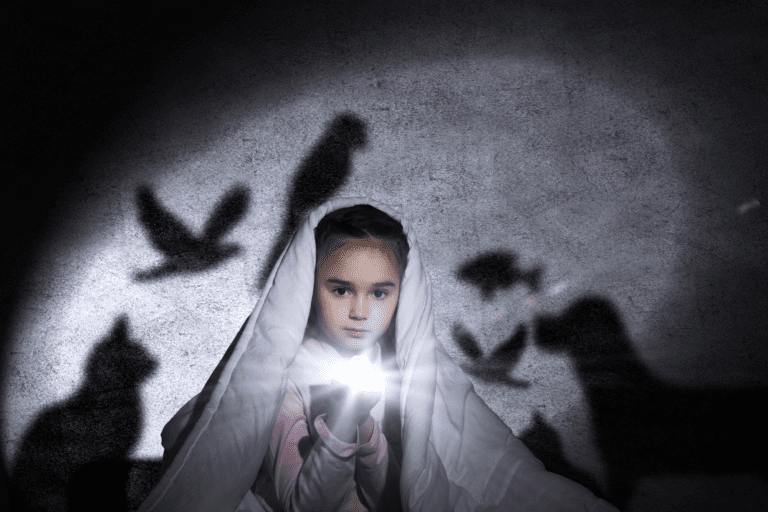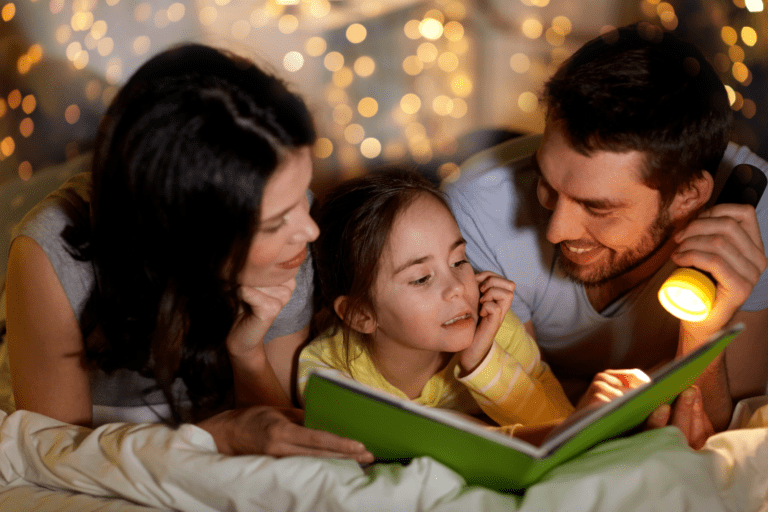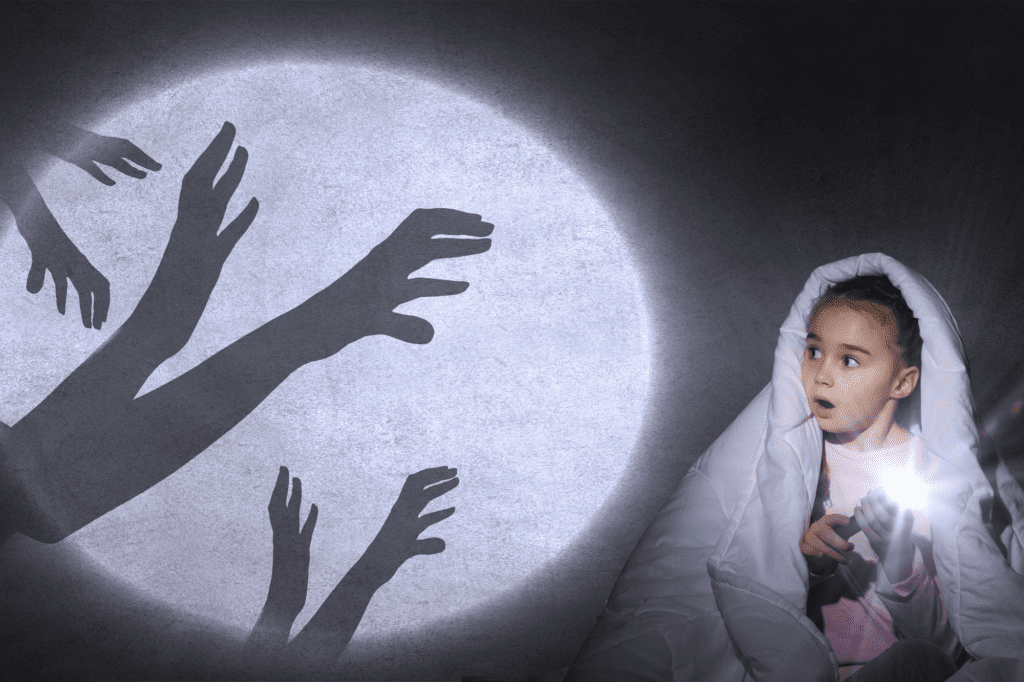How to Handle Fear of the Dark
Darkness is one of the number one things I stress to parents when preparing their child’s sleep environment. Babies, children and even adults sleep best in a dark room. This doesn’t change as our babies get older, but what does tend to change is that your child can develop a fear of the dark.
I’m going to be sharing how to handle your child’s fear of the dark while still ensuring you all continue to get a full night’s sleep. First, let’s talk about why darkness is important for sleep. Our circadian rhythm is tied to light exposure. In the simplest terms, we’re awake when it’s light out and we’re asleep when it’s dark. In response to darkness our brain starts producing Melatonin, the sleepy hormone.
When our eyes are exposed to artificial light (like the blue light from screens) it actually blocks melatonin production and can make it much harder for us to settle down and fall asleep. Light exposure at nighttime can also affect how your child transitions sleep cycles causing more night wakings and fragmented sleep.
So, we know that darkness is a key ingredient for a restful night’s sleep and that’s easy to achieve in the early stages. When your toddler or child starts to communicate more and tells you they are afraid of the dark, how should you respond?

1. Listen to Their Concerns
We know that toddlers can be master stallers when it comes to bedtime, but you want to make sure that you don’t shrug off what they’re telling you. If you child is expressing fears around bedtime it’s important to listen to their concerns. Try to find out if something has changed or what about the dark is scaring them.
Sometimes shadows on the wall can look scary to our little ones or they may have seen something on a TV show which has now created a new fear. Ensure your child that they are safe and that mommy and daddy are still right down the hall if they need you.
Try not to introduce any new check ins or sleep props if your child is able to fall asleep independently. Some extra reassurance may be needed as you navigate this new fear. If you do need to spend more time with your child, it’s important to keep them in their room versus them coming into your room. If this is a struggle I have a blog all about how to keep your toddler in their bed.
2. Do Not Use Monster Spray
While you want to listen to your child’s concerns, you don’t want to validate their fear by checking for monsters or using a “monster spray”. This may sound harmless and a great way to ensure your child that their room is safe, but in reality, it can amplify the situation.
By checking for monsters or “spraying for monsters” you’ve just shown your child that monsters do in fact exist, but that for now there are none here. What if you forget to do a monster check one night or forget the “monster spray” while on vacation? I have some other suggestions that will help your child cope without going on a monster hunt every bedtime.

3. Spend Time Together in the Dark
Make being in the dark fun. Play flashlight tag. Use flashlights to make shadows on a wall. Talk about how shadows are not bad; they are simply part of the room. In the daytime, sit in the dark room with your child and look for shadows. Look at them and talk about how they are simply a part of the room and how they are made. Help your child understand that it isn’t necessary to make shadows go away (in fact we can’t) but he can know what they are and that they are harmless. Have a treasure hunt and search for things that glow in the dark. This will help your child conquer their fear of the dark.
4. Use a Nightlight
There will come a time when you won’t be able to keep your child’s room pitch black anymore and they will want a nightlight. In fact, I experienced this myself very recently with my 3.5 year old. She started protesting and crying at bedtime and not wanting to go to sleep without me. Although she didn’t come right out and say she was afraid of the dark, I suggested using a night light and it worked wonders.
It’s important to give your toddler choices, so if they are asking for a nightlight let them choose the color nightlight and possibly where you should put the nightlight. Lay down some ground rules as well. If your child wants to use a nightlight they have to stay in bed and lay quietly, no getting out of bed or calling for you. Again, this was a game changer for my toddler. She knows that the light stays on all night as long as she stays in bed. If she calls for me it’s to use the potty.
I highly recommend using the Hatch Baby Rest because this device makes it super easy to control the color, brightness level, type and level of the sound. You can also control it from your device outside of the room. Stay away from cool colors (like blue, purple and green) and use more warm colors (like red, yellow or orange). Remember, blue light blocks melatonin production.

5. Use a Comfort Item
Along with using a nightlight your child may find comfort in having a stuffed animal or comfort item nearby for when they’re in bed. Help your child find a security object that will help them feel more relaxed and comforted at bedtime and throughout the night.
It could be a different stuffed animal each night or maybe it’s a special blanket or pillow. Some toddlers become very attached to a sleep sack or blanket which can be very comforting. When you tuck your child in at night make sure they have their comfort item with them.
Sleep is ever changing with our little ones. Fear of the dark is a natural progression as our toddler’s mind matures and their imagination develops. If you’re struggling with your child’s sleep and need some help navigating bedtime, reach out for support. Book a free sleep solution call so we can talk more about your child and your family’s goals. With a customized sleep plan and follow up support you’ll all be resting easy soon.

